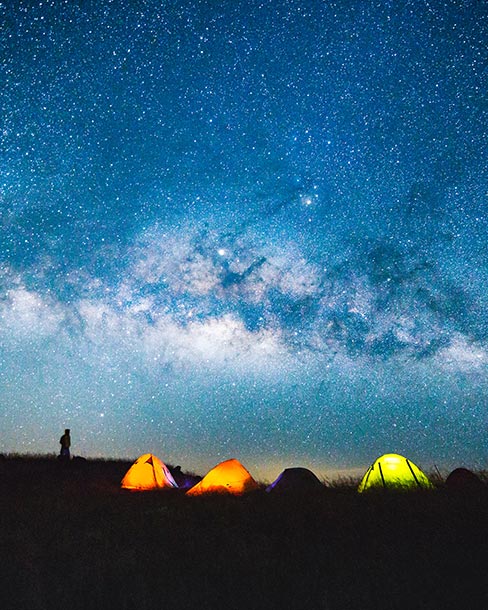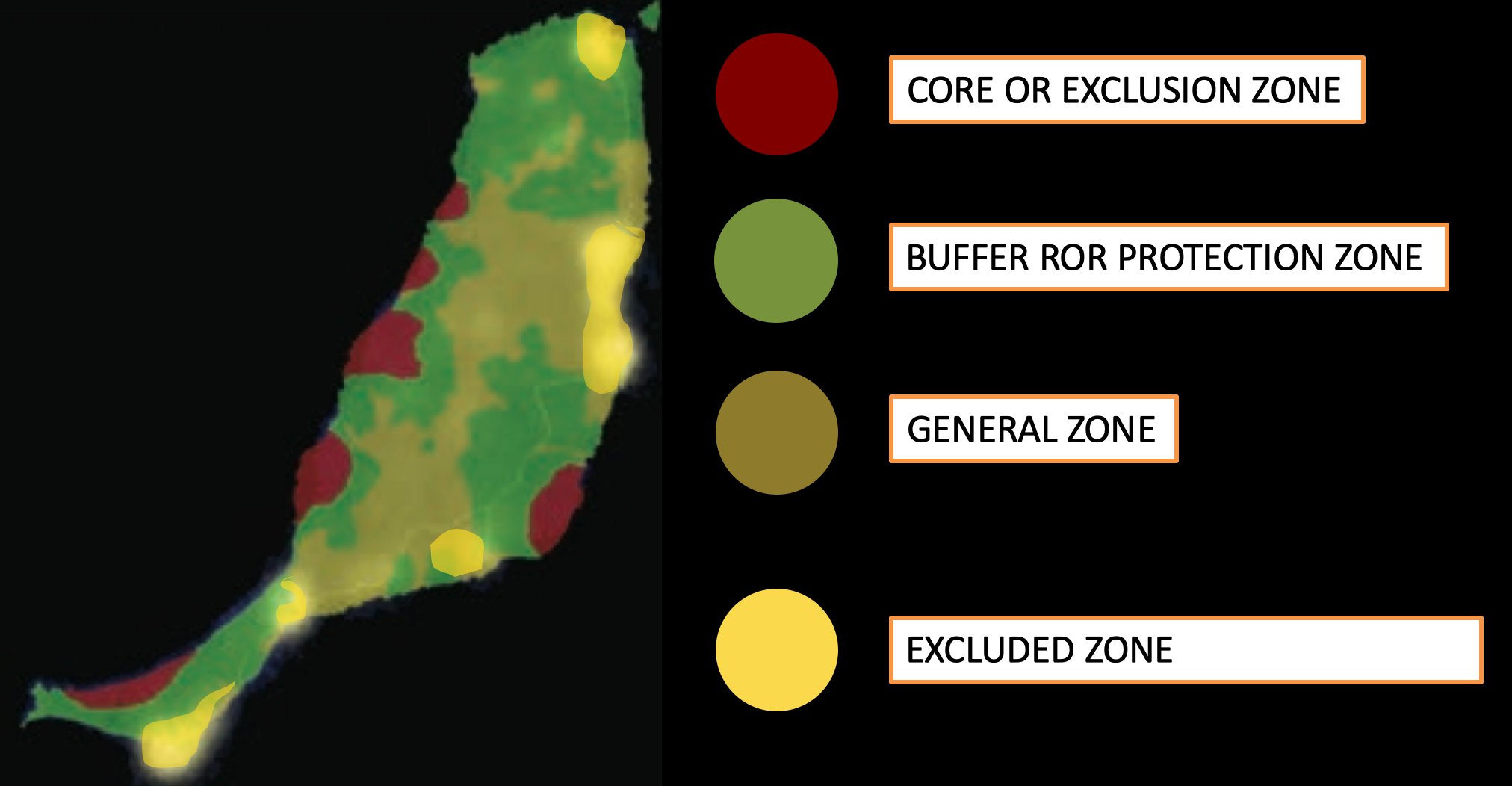
DEFINITION
STARLIGHT TOURIST DESTINATIONS
Starlight Tourist Destinations are visitable sites with very good conditions for observing the stars , which are protected from light pollution and are suitable for tourist activities based on the stars as an integral part of Nature.
Starlight Tourist Destinations must undergo accreditation for sky quality and the measures in place to protect it, as well as the infrastructure and tourist offer in place at the site (including accommodation, specialist infrastructures and supporting facilities, trained staff for astronomical interpretation, etc.) and their integration into the natural night time environment on which they are based. If the site does not have yet these facilities and activities, the Starlight Foundation evaluates the project to develop them in the future.
Starlight certification makes it possible to bring science and tourism together for the first time, through a new kind of intelligent tourism based on astronomy and the sky and with innovative criteria for responsible development. At the hearth of certification lies an understanding of science as both a tourist product and a way of working for tourism.
This Certification was born with the aim of fostering, worldwide, the improvement of the quality of tourist experiences and the protection of the night skies in Starlight Destinations. The criteria were established in December 2010, in UNWTO Centre in Madrid, with representatives of UNESCO, UNESCO-Mab and IAC.
Moreover, Starlight as a whole is an integrated action of UNESCO and is supported by IAU and UNWTO, emerged from the IAC (https://www3.astronomicalheritage.net/index.php/resources/dark-skies-info)
The Starlight Tourist Certification System was created with the aim of fostering, worldwide, the improvement of the quality of tourist experiences and the protection of the night skies in Starlight Destinations.
The award of Starlight Destination Certification follows a specific procedure established by the Starlight Foundation.
What is assessed?
Sky quality parameters
Sky quality is the sine qua non for Starlight Destination Certification. Conformity with the requirements values for astronomical parameters determining sky quality is therefore the first step in the certification procedures.
Clear skies, sparse light pollution, excellent clarity (good seeing) and the transparency of the air are the fundamental conditions required for astronomical observations and so also for developing star tourism. These parameters are:
- Sky brightness
- Seeing
- Transparency
- Cloud coverage (useful time)
Certification may also be seasonal, where conditions are only met during part of the year (perhaps a few months) due, for example, to weather conditions at the site.
Parameters for the tourism offer and action on the environment at the destination
The audit will first look at action on the environment at the destination and the extent to which its promoters are complying with the principles and recommendations of the Starlight Destination. The emphasis of the audit will be on environmental action taken to protect the destinations most importante resource, its night sky, by preventing light pollution.
This phase will assess sustainable criteria and, especially, criteria for promoting and protecting other natural and cultural resources relevant for star observation. The strenghts, opportunities, weaknesses and threats of each of tourist resources will be assessed.
The audit will focus on parameters for the destination's tourist products and its star tourism offer. In view of special characteristics, where understanfding astronomy is vital for excellence, special attention will paid to arrangements for knowledge management, educational activities and the level of training of principal personnel, particularly guides and interpreters.
The certification system will therefore look at eight different areas in order to evaluate the measures already in place and the activities and attraction at the destination:
- Mission, values and objectives.
- Regulation and governance of the Starlight tourist destination.
- Strategy, Action Plan and Information System.
- Conservation and other relevant natural and cultural resources.
- Tourist product: attractions, services and infrastructures.
- Knowledge management, training and education.
- Control and monitoring of Starlight programmes.
- Management and monitoring of the Starlight tourist destination.
Area and zoning
A Starlight Touristic Destination has several areas:
Core zone: This is where the conditions of natural illumination and night sky clarity are kept intact.
Buffer zone: The buffer zone is the protective area that surrounds the core zone in the face of possible adverse effects that may deteriorate the quality of the night sky. Buffer zones may include small human settlements and activity areas. A buffer zone or high-sensitivity zone is considered to be the entire nearby area with a direct view of the core zone, encompassing a safety contour in which it is ensured that the effects of light or air pollution do not affect the core zone.
External or general area: this is the area of general use where the population settlements that can influence the evolution of the quality of the night sky in the tourist destination as a whole.
An area may be excluded from the scope of Starlight certification if it does not meet the requirements. This area could be incorporated into the certified scope in subsequent reviews if it demonstrates improvement and compliance.

Actions and benefits of star tourism by Starlight:
- The Starlight Foundation assesses in lighting projects and in the drafting of ordinances and regulations of reduction of the lighting pollution with the subsequent energy and economic saving, helping to preserve natural spaces and fighting the climate change.
- The preservation of the night sky has its direct benefits on biodiversity, the environment and health due to its impact in the chrono disruption or alteration of the circadian cycles of many species included human.
- The starred night is part of a landscape, sky scape, which the population of each territory perceives and which must be added to the rest of the landscapes of the nature.
- We have created a national and international network of sustainable territories/lodgings with which create synergies and export experiences for sustainable economic development.
- The tourism of stars according to the Starlight criteria is a modality of responsible tourism, sustainable and innovative, which promotes the creation of quality employment and the diversification of the current offer of companies and agencies dedicated to the touristic industry.
- The tourism we promote is a powerful tool to disseminate astronomy.
- The star tourism achieves the widening of the overnight stay, achieves the diversification away from seasonal tourism (sky 24 hours x 365 days/year) and the decentralization of the tourist offer.
- The star tourism is a sustainable economy engine and a powerful tool against depopulation.
- It fosters the creation of new areas (recovering some abandoned such as churches, lighthouses, houses of forest rangers, etc.) for the diffusion of astronomy.
- The star tourism from the point of view of Starlight is a generator of quality employment.
- It is a revaluation of the cultural, historic, environmental, of biodiversity, ethnographic, etc. heritage of the territory, since all activities are intended to its preservation, empowering local communities.
- The Starlight Foundation promotes initiatives of inclusive tourism, boosts tourism as a peace instrument in conflict areas and impoverished and promotes sustainable development actions and education in impoverished rural environments.
- The Starlight Foundation draws attention to the role of the woman and girl in science and in astronomy, raising scientific vocations among the younger and empowering the training of women as Starlight monitors.
Contact
+34 922 31 51 40
gestion@fundacionstarlight.org
Calle Vía Láctea S/N 38205 San Cristóbal de La Laguna, Tenerife, España